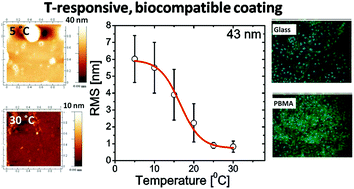当前位置:
X-MOL 学术
›
J. Mater. Chem. B
›
论文详情
Our official English website, www.x-mol.net, welcomes your
feedback! (Note: you will need to create a separate account there.)
Glass transition in temperature-responsive poly(butyl methacrylate) grafted polymer brushes. Impact of thickness and temperature on wetting, morphology, and cell growth
Journal of Materials Chemistry B ( IF 6.1 ) Pub Date : 2018-02-09 00:00:00 , DOI: 10.1039/c8tb00088c Yurij Stetsyshyn 1, 2, 3 , Joanna Raczkowska 4, 5, 6, 7 , Ostap Lishchynskyi 1, 2, 3 , Kamil Awsiuk 4, 5, 6, 7 , Joanna Zemla 7, 8, 9 , Pawel Dąbczyński 4, 5, 6, 7 , Andrij Kostruba 3, 10, 11 , Khrystyna Harhay 1, 2, 3 , Halyna Ohar 1, 2, 3 , Barbara Orzechowska 7, 8, 9 , Yurij Panchenko 1, 2, 3 , Petro Vankevych 3, 12, 13 , Andrzej Budkowski 4, 5, 6, 7
Journal of Materials Chemistry B ( IF 6.1 ) Pub Date : 2018-02-09 00:00:00 , DOI: 10.1039/c8tb00088c Yurij Stetsyshyn 1, 2, 3 , Joanna Raczkowska 4, 5, 6, 7 , Ostap Lishchynskyi 1, 2, 3 , Kamil Awsiuk 4, 5, 6, 7 , Joanna Zemla 7, 8, 9 , Pawel Dąbczyński 4, 5, 6, 7 , Andrij Kostruba 3, 10, 11 , Khrystyna Harhay 1, 2, 3 , Halyna Ohar 1, 2, 3 , Barbara Orzechowska 7, 8, 9 , Yurij Panchenko 1, 2, 3 , Petro Vankevych 3, 12, 13 , Andrzej Budkowski 4, 5, 6, 7
Affiliation

|
Poly(n-butyl methacrylate) (PBMA) grafted polymer brushes attached to glass were fabricated in a three-step process involving surface initiated atom transfer radical polymerization. The surface properties of the coatings after subsequent fabrication steps were confirmed using ToF-SIMS and ellipsometry. Measurements of water contact angle and AFM revealed temperature-induced changes in the hydrophobicity and morphology of the coating. The glass transition temperatures (Tg) of the PBMA coatings with different thicknesses were determined from the AFM measurements. For the PBMA grafted brush coatings with thicknesses less than 62 nm, Tg increases sharply with increasing thickness. The PBMA grafted coatings of thickness equal to 86 nm and 43 nm as well as control glass substrates were used as substrates for culturing a urinary bladder cancer HTB-5 cell line. After 144 h of culturing, a well-developed monocellular layer may be observed on the PBMA coating of thickness equal to 86 nm. In turn, the cells incubated on thinner (43 nm) PBMA coatings as well as on a control glass sample only start to form a confluent layer.
中文翻译:

温度响应型聚甲基丙烯酸丁酯接枝聚合物刷中的玻璃化转变。厚度和温度对润湿,形态和细胞生长的影响
连接到玻璃上的聚甲基丙烯酸正丁酯(PBMA)接枝的聚合物刷是通过三步过程制造的,该过程涉及表面引发的原子转移自由基聚合。在随后的制造步骤之后,使用ToF-SIMS和椭偏仪确认了涂层的表面性能。水接触角和AFM的测量揭示了温度引起的涂层疏水性和形态的变化。由AFM测量确定具有不同厚度的PBMA涂层的玻璃化转变温度(T g)。对于厚度小于62 nm的PBMA接枝刷涂层,T g随着厚度的增加急剧增加。厚度等于86nm和43nm的PBMA接枝涂层以及对照玻璃基底用作培养膀胱癌HTB-5细胞系的基底。培养144小时后,可以在PBMA涂层上观察到厚度等于86 nm的发达的单细胞层。反过来,在较薄(43 nm)PBMA涂层以及对照玻璃样品上孵育的细胞仅开始形成融合层。
更新日期:2018-02-09
中文翻译:

温度响应型聚甲基丙烯酸丁酯接枝聚合物刷中的玻璃化转变。厚度和温度对润湿,形态和细胞生长的影响
连接到玻璃上的聚甲基丙烯酸正丁酯(PBMA)接枝的聚合物刷是通过三步过程制造的,该过程涉及表面引发的原子转移自由基聚合。在随后的制造步骤之后,使用ToF-SIMS和椭偏仪确认了涂层的表面性能。水接触角和AFM的测量揭示了温度引起的涂层疏水性和形态的变化。由AFM测量确定具有不同厚度的PBMA涂层的玻璃化转变温度(T g)。对于厚度小于62 nm的PBMA接枝刷涂层,T g随着厚度的增加急剧增加。厚度等于86nm和43nm的PBMA接枝涂层以及对照玻璃基底用作培养膀胱癌HTB-5细胞系的基底。培养144小时后,可以在PBMA涂层上观察到厚度等于86 nm的发达的单细胞层。反过来,在较薄(43 nm)PBMA涂层以及对照玻璃样品上孵育的细胞仅开始形成融合层。











































 京公网安备 11010802027423号
京公网安备 11010802027423号